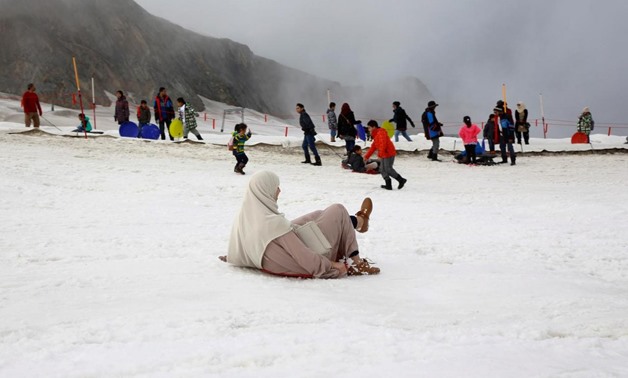
Arab tourists enjoy some snow on top of Kitzsteinhorn mountain near Zell am See, Austria, August 30, 2016. REUTERS/Leonhard Foeger
18 November 2017: Going quickly from low altitude to high altitude can cause headache, fatigue and nausea, the American Medical Association warns in a new publication directed at travelers.
Acute mountain sickness affects more than one in four people who travel above 3,500 meters, or 11,600 feet, and more than half of those who travel above 6,000 meters, or 20,000 feet.
Many popular ski resorts in the Rocky Mountains and the Alps, for example, are well above those elevations.
“With winter and the holiday season approaching, it’s time for travelers to be careful as they visit high altitudes,” said Dr. Jill Jin of Northwestern University in Evanston, Illinois, who wrote the one-page primer online November 14 in JAMA.
“It’s important to talk about the signs, symptoms and treatment,” she told Reuters Health by phone.
Headache, fatigue, poor appetite, nausea, vomiting, light-headedness and sleep disturbances that develop six to 12 hours after ascent all can be symptoms of acute mountain sickness, the article warns. The problems usually improve in one or two days if the traveler doesn’t go higher. In fewer than 1% of cases, symptoms can grow worse and turn into high-altitude cerebral edema.
“Everyone is susceptible, even if you’re young,” Jin said. “Everyone can experience it, regardless of gender and age.”
Acute mountain sickness is easy to diagnose in healthy adults but can be harder to spot in children and those with health problems.
Treatment usually includes rest, hydration and pain medicine for headaches. Some patients need supplemental oxygen. Some prescription medicines, such as acetazolamide and dexamethasone, can help. People with persistent severe symptoms should go back down to a lower altitude.
“This is a public health problem in places such as Colorado. Millions of people visit the mountains every year, and it affects how people enjoy their trip,” said Dr. Chris Davis of the University of Colorado at Denver, Anschutz Medical Campus, who researches high altitude sickness, frostbite and avalanche injury patterns.
“This is high season for Colorado mountain resorts when people plan their Thanksgiving, Christmas, New Year’s and other holiday travel here,” he told Reuters Health by phone. “An ounce of prevention pays off in the long term.”
“There’s a myth that fitness drives your risk,” Davis said. “It’s based on genetics, so even if you’re fit, you may experience it.”
The JAMA paper says a gradual ascent of 400 meters, or 1,333 feet per day - especially for sleeping at night - can help prevent acute mountain sickness. Travelers can also try pre-acclimatization, or regular exposure to altitude, as well as hydrating with water and avoiding alcohol.
Those who have experienced high altitude sickness before should be especially careful, Jin advises. Patients with heart disease, lung disease, anemia and obstructive sleep apnea should talk to their doctors before traveling to high altitudes.
Davis pointed out that while the paper mentions high-altitude cerebral edema, it doesn’t discuss lung edema, which, while rare, is more common and also carries the risk of severe symptoms and death.
“Mountaineers know the tips and tricks of gradual ascent up high altitudes, but some tourists fly from sea level to a city and then immediately drive to the mountains,” he said. “Instead, spend the night in Denver, for example, and split up the trip to lower your risk.”
An accompanying article in JAMA reviews the existing research on instruments to use for diagnosing acute mountain sickness. The “clinical functional score” is highlighted as the simplest of the available instruments.


Comments
Leave a Comment